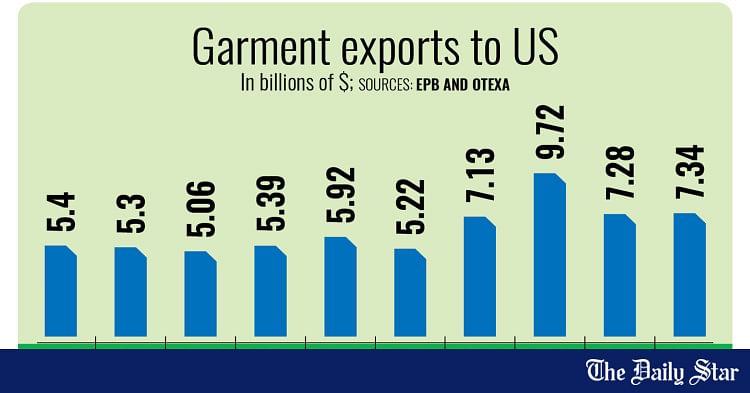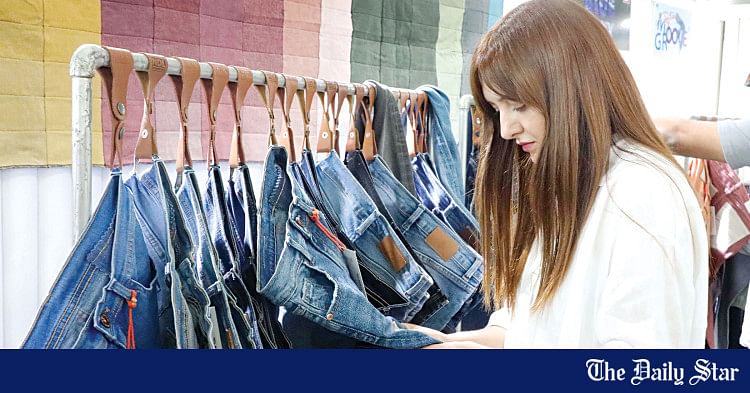Saif
Senior Member
- Joined
- Jan 24, 2024
- Messages
- 15,898
- Likes
- 7,990
- Nation

- Axis Group


Lotus Silk: Weaving possibilities in a fine fabric
A group of skilled artisans in Bangladesh have now created a special scarf made from yarn derived from lotus stems, known as Lotus Silk.
Lotus Silk: Weaving possibilities in a fine fabric
Sheikh Saifur Rahman
Published: 08 Mar 2025, 11: 32

Extracting fiber from lotus stems
The world renowned gossamer-fine Dhaka Muslin spun from Phuti Karpas cotton disappeared from the scene. The intricate craftsmanship was lost to the world.
A few years ago, Dhaka Muslin saw a revival. A group of skilled artisans in Bangladesh achieved what was once thought impossible. They did not stop there. They have now created a special scarf made from yarn derived from lotus stems, known as Lotus Silk.
Unique properties of lotus silk
The colour of lotus silk yarn is a light milky yellow. This yarn is derived from a sticky resin found in lotus stems. The silk made from this yarn is called Lotus Silk, one of the most expensive fabrics in the world. The price of one kilogram of lotus silk yarn ranges from $2,000 to $3,500 (about Tk 427,000), and the price of fabric per yard varies between $25 and $1,000.
Countries such as Myanmar, Vietnam, and Cambodia have a long history of producing and using lotus silk. However, in Bangladesh, the use of lotus silk is a recent development.
A six-yard scarf was recently woven using the Jamdani weaving technique on a pit loom. This scarf has been presented to UNESCO and is currently displayed at the Bangladesh National Commission for UNESCO in Segunbagicha, Dhaka. Anyone interested can visit and see the scarf.
Experts and researchers believe that the successful production of lotus silk in Bangladesh has opened new doors for the textile industry. Since Bangladesh has numerous lotus-filled wetlands that remain flooded year-round, lotus stems can be collected at any time.

Artisan Achhia Begum holding her hand-woven lotus silk fabric
Prime prospects for Bangladesh
Padma (lotus) researcher and Chairman of Bengal Plants Research & Development (BPRD), Shikdar Abul Kashem Shamsuddin, expressed his optimism, saying, "Since labour costs are lower in Bangladesh, the cost of yarn spinning and fabric production will be reduced. This will make it easier for us to compete in the international market."
An eco-friendly yarn
Lotus stems contain numerous small pores that store a sticky substance. When exposed to air, this resin solidifies and is skillfully spun into yarn. This yarn dries quickly in the air without needing sunlight.
The stems of the pink lotus (Nelumbo nucifera) are ideal for producing lotus silk yarn, although other lotus varieties can also be used. Compared to cotton or mulberry silk, lotus silk is stronger, more durable, and 100% water-resistant. Though it lacks high elasticity, it does not wrinkle. This yarn is naturally lustrous, soft, and breathable, making it highly receptive to dyes that enhance its beauty.
Since lotus silk is made from natural materials, its production does not harm insects, unlike other silk industries. It requires no water or fossil fuel usage, making it a zero-carbon-emission process.
Various uses of the lotus
The pink lotus is considered sacred in Hinduism and Buddhism. One of its remarkable properties is its ability to purify water naturally. Lotus flowers are also renowned for their medicinal properties, and the pollen (stamens) of the lotus is used to make expensive herbal tea.
Lotus stems and young leaves can be cooked and eaten, while the root is an excellent source of carbohydrates. Due to its medicinal value, lotus is now commercially cultivated in various countries. White lotus petals are used to make perfumes. Countries such as China, India, Japan, Korea, Vietnam, Myanmar, Thailand, and Cambodia have diverse applications for lotus.
Commercial potential in Bangladesh
Bangladesh has 35–40 large lotus-filled wetlands, most of which are government-owned. These wetlands remain waterlogged year-round, allowing for a continuous supply of lotus stems.
When lotus stems are cut, new ones grow underwater, with a growth rate of 6–8 inches per day. This allows for at least five harvests per month. According to researcher Shikdar Abul Kashem Shamsuddin, the entire process, from stem collection to fabric production, takes about a month.
By breaking a lotus stem every inch, a sticky resin is released, which is then spun into yarn. If more stems are used, the yarn becomes thicker; if fewer stems are used, the yarn remains finer. This characteristic is similar to Phuti Karpas cotton, making it easy for Bangladeshi women to spin fine-quality yarn.
Women from Ronkoil village in Kanaipur, Faridpur, have proven this by successfully spinning excellent yarn after just three days of training. Within six months, they were able to produce ultra-fine yarn.
In Bangladesh, the best time for yarn production is from August to December, when lotus flowers are abundant. Since this silk production is directly related to agriculture, it can create a new source of income for rural women. If this project is implemented commercially, many skilled yarn spinners will emerge across different districts, making them financially independent.

Lotus silk threads in various colours
In Cambodia and Vietnam, approximately 30,000 lotus stems are needed to produce one kilogram of yarn. However, in Bangladesh, the same amount of yarn can be produced with just 15,000 lotus stems, according to Md. Ayub Ali, head of planning and implementation at the Bangladesh Handloom Board.
Key People behind the project
The Bengal Plants Research & Development (BPRD) initiated a project titled “Diversity, Usability, and Conservation of Lotus” to develop the lotus silk scarf.
Key contributors to the project include: Dr. Rakhahari Sarkar, Supernumerary professor at Dhaka University was involved in the project as an advisor. Md. Manjurul Islam, Operations Manager at the Handloom Board, assisted in yarn spinning and dyeing. He was also assisted by Md. Mohaiminul Islam, who also worked in the Muslin Project.
The lotus silk fabric was woven by master weaver Achhia Begum from Sonargaon.
Md. Tajuddin, Senior Program Officer of the Bangladesh National Commission for UNESCO, provided valuable guidance and support to implement the lotus research and of lotus silk weaving.
The research project was funded and supervised by the Bangladesh National Commission for UNESCO.
Need for proper planning
Based on the experience of the pilot project, Md. Ayub Ali believes that if Bangladesh starts commercial production, it will require fewer lotus stems than other countries to produce yarn, allowing for the production of finer-quality silk.
Additionally, jacquard and semi-automatic looms can be used to scale up fabric production.
According to analysts and researchers, lotus silk could be Bangladesh's trump card in the global luxury fashion market. With proper planning and execution, Bangladesh has the potential to carve out a unique position in the global textile industry with lotus silk.
Sheikh Saifur Rahman
Published: 08 Mar 2025, 11: 32
Extracting fiber from lotus stems
The world renowned gossamer-fine Dhaka Muslin spun from Phuti Karpas cotton disappeared from the scene. The intricate craftsmanship was lost to the world.
A few years ago, Dhaka Muslin saw a revival. A group of skilled artisans in Bangladesh achieved what was once thought impossible. They did not stop there. They have now created a special scarf made from yarn derived from lotus stems, known as Lotus Silk.
Unique properties of lotus silk
The colour of lotus silk yarn is a light milky yellow. This yarn is derived from a sticky resin found in lotus stems. The silk made from this yarn is called Lotus Silk, one of the most expensive fabrics in the world. The price of one kilogram of lotus silk yarn ranges from $2,000 to $3,500 (about Tk 427,000), and the price of fabric per yard varies between $25 and $1,000.
Countries such as Myanmar, Vietnam, and Cambodia have a long history of producing and using lotus silk. However, in Bangladesh, the use of lotus silk is a recent development.
A six-yard scarf was recently woven using the Jamdani weaving technique on a pit loom. This scarf has been presented to UNESCO and is currently displayed at the Bangladesh National Commission for UNESCO in Segunbagicha, Dhaka. Anyone interested can visit and see the scarf.
Experts and researchers believe that the successful production of lotus silk in Bangladesh has opened new doors for the textile industry. Since Bangladesh has numerous lotus-filled wetlands that remain flooded year-round, lotus stems can be collected at any time.
Artisan Achhia Begum holding her hand-woven lotus silk fabric
Prime prospects for Bangladesh
Padma (lotus) researcher and Chairman of Bengal Plants Research & Development (BPRD), Shikdar Abul Kashem Shamsuddin, expressed his optimism, saying, "Since labour costs are lower in Bangladesh, the cost of yarn spinning and fabric production will be reduced. This will make it easier for us to compete in the international market."
An eco-friendly yarn
Lotus stems contain numerous small pores that store a sticky substance. When exposed to air, this resin solidifies and is skillfully spun into yarn. This yarn dries quickly in the air without needing sunlight.
The stems of the pink lotus (Nelumbo nucifera) are ideal for producing lotus silk yarn, although other lotus varieties can also be used. Compared to cotton or mulberry silk, lotus silk is stronger, more durable, and 100% water-resistant. Though it lacks high elasticity, it does not wrinkle. This yarn is naturally lustrous, soft, and breathable, making it highly receptive to dyes that enhance its beauty.
Since lotus silk is made from natural materials, its production does not harm insects, unlike other silk industries. It requires no water or fossil fuel usage, making it a zero-carbon-emission process.
Various uses of the lotus
The pink lotus is considered sacred in Hinduism and Buddhism. One of its remarkable properties is its ability to purify water naturally. Lotus flowers are also renowned for their medicinal properties, and the pollen (stamens) of the lotus is used to make expensive herbal tea.
Lotus stems and young leaves can be cooked and eaten, while the root is an excellent source of carbohydrates. Due to its medicinal value, lotus is now commercially cultivated in various countries. White lotus petals are used to make perfumes. Countries such as China, India, Japan, Korea, Vietnam, Myanmar, Thailand, and Cambodia have diverse applications for lotus.
Commercial potential in Bangladesh
Bangladesh has 35–40 large lotus-filled wetlands, most of which are government-owned. These wetlands remain waterlogged year-round, allowing for a continuous supply of lotus stems.
When lotus stems are cut, new ones grow underwater, with a growth rate of 6–8 inches per day. This allows for at least five harvests per month. According to researcher Shikdar Abul Kashem Shamsuddin, the entire process, from stem collection to fabric production, takes about a month.
By breaking a lotus stem every inch, a sticky resin is released, which is then spun into yarn. If more stems are used, the yarn becomes thicker; if fewer stems are used, the yarn remains finer. This characteristic is similar to Phuti Karpas cotton, making it easy for Bangladeshi women to spin fine-quality yarn.
Women from Ronkoil village in Kanaipur, Faridpur, have proven this by successfully spinning excellent yarn after just three days of training. Within six months, they were able to produce ultra-fine yarn.
In Bangladesh, the best time for yarn production is from August to December, when lotus flowers are abundant. Since this silk production is directly related to agriculture, it can create a new source of income for rural women. If this project is implemented commercially, many skilled yarn spinners will emerge across different districts, making them financially independent.
Lotus silk threads in various colours
In Cambodia and Vietnam, approximately 30,000 lotus stems are needed to produce one kilogram of yarn. However, in Bangladesh, the same amount of yarn can be produced with just 15,000 lotus stems, according to Md. Ayub Ali, head of planning and implementation at the Bangladesh Handloom Board.
Key People behind the project
The Bengal Plants Research & Development (BPRD) initiated a project titled “Diversity, Usability, and Conservation of Lotus” to develop the lotus silk scarf.
Key contributors to the project include: Dr. Rakhahari Sarkar, Supernumerary professor at Dhaka University was involved in the project as an advisor. Md. Manjurul Islam, Operations Manager at the Handloom Board, assisted in yarn spinning and dyeing. He was also assisted by Md. Mohaiminul Islam, who also worked in the Muslin Project.
The lotus silk fabric was woven by master weaver Achhia Begum from Sonargaon.
Md. Tajuddin, Senior Program Officer of the Bangladesh National Commission for UNESCO, provided valuable guidance and support to implement the lotus research and of lotus silk weaving.
The research project was funded and supervised by the Bangladesh National Commission for UNESCO.
Need for proper planning
Based on the experience of the pilot project, Md. Ayub Ali believes that if Bangladesh starts commercial production, it will require fewer lotus stems than other countries to produce yarn, allowing for the production of finer-quality silk.
Additionally, jacquard and semi-automatic looms can be used to scale up fabric production.
According to analysts and researchers, lotus silk could be Bangladesh's trump card in the global luxury fashion market. With proper planning and execution, Bangladesh has the potential to carve out a unique position in the global textile industry with lotus silk.










































